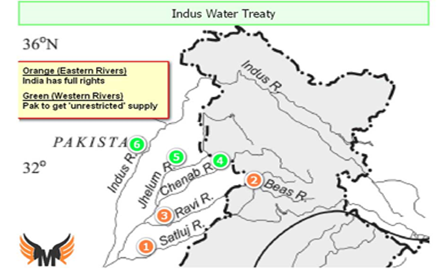

Context
India has announced to reconsider its Indus Water Treaty (IWT) with Pakistan citing disputes over the Kishenganga and Ratle hydropower projects in Jammu & Kashmir.
What is India’s present stand on IWT?
- New Delhi has issued a noticeto Islamabad seeking modification of the Indus Waters Treaty (IWT) under Article XII (3) of the IWT which deals with the “final provisions” of the treaty.
- The notice follows Pakistan’s continued “intransigence” in implementing the treaty, by raising repeated objections to the construction of hydel projects on the Indian side.
- The notice, sent on January 25 through the Commissioner for Indus Waters, gives Pakistan 90 days to consider entering into intergovernmental negotiations to rectify the material breach of the treaty.
- India also boycotted the Pakistani case at the Permanent Court of Arbitrationat The Hague in the Netherlands.
- India mentioned that they were left with no choice but to demand that Pakistan come to the table to negotiate amendments to the treaty.
Indus Water Treaty (IWT), 1960:
- The six-decade-old treaty governs the sharing of waters of six rivers in the Indus system between the two countries.
- Main Rivers:Indus River, Jhelum, Chenab, Ravi, Beas, and Sutlej.
- The basin is mainly shared by India and Pakistanwith a small share of China and Afghanistan.
- Under the treaty signed between India and Pakistan in 1960, all the waters of
- Eastern rivers, namely Ravi, Sutlej, and Beas (Eastern Rivers) were allocated to India for exclusive use
- Western rivers - Indus, Jhelum, and Chenabwere allocated to Pakistan except for specified domestic, non-consumptive, and agricultural use permitted to India as provided in the Treaty.
- India has also been given the right to generate hydroelectricitythrough run-of-the-river (RoR) projects on the Western Rivers which, subject to specific criteria for design and operation is unrestricted.
|
River Indus: Geographic Location
|

The objected projects
- India is constructing two hydroelectric power projects on:
- Kishanganga river, a tributary of Jhelum
- Chenab
- Pakistan has raised objections to these projects, and dispute resolution mechanisms under the Treaty have been invoked multiple times. But a full resolution has not been reached.
What is the dispute all about between India and Pakistan?
- Both countries held different positions when Pakistan raised objections regarding the technical design features of the Kishanganga (330MW) and Ratle (850 MW) hydroelectric power plantslocated on the tributaries of the Jhelum and the Chenab, respectively, designated as “Western Rivers”.
- However, under Articles III and VII of the treaty, India is permitted to construct hydroelectric power facilities on these rivers (subject to constraints specified in Annexures to the Treaty).
- Differences were also discernible when Pakistan approached the World Bank to facilitatethe setting up of a court of arbitration to address the concerns related to these two projects referred to in Article IX Clause 5 of the treaty, and when India requested the appointment of a Neutral Expert referent to Clause 2.1 of Article IX on the settlement of differences and dispute of the treaty, respectively.
- Pakistan, invoking Article VII Clause 2 on future cooperation, raised objections on the construction and technical designs of the Pakal Dul and Lower Kalnai hydropower plants located on the Marusudar River, a tributary of the Chenab, in the Kishtwar district of Jammu and Kashmir.
- India has raised concerns on issues such as Pakistan’s blockade of the Fazilka drain, which resulted in water contamination in the border areas.

